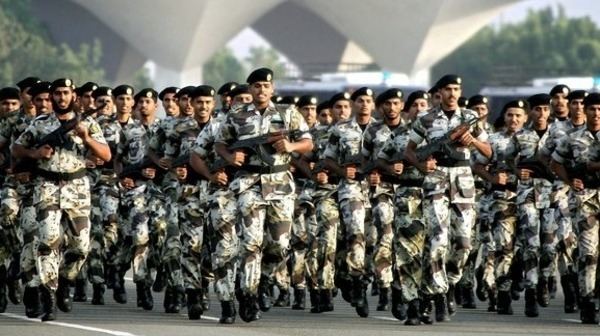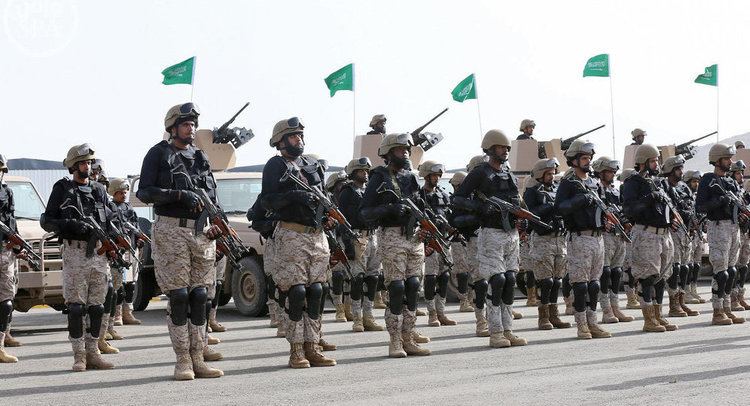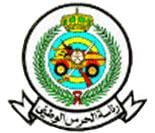Country Arabian Kingdom | ||
Allegiance Custodian of the Two Holy Mosques Branch Saudi Military Forces (as of 1917) Role Counter insurgency, armed responseto civil unrest, counter terrorism. Size 225,000 full-time personnel25,000 reservists personnel250,000 total personnel (May 2013 est.) Part of MONG (as of 2013)N.G. Presidency (1954– 2013)N.G. Bureau (1947– 1954) Notable commander Abdullah of Saudi Arabia (1963–2010) Engagements Gulf War, Saudi Arabian-led intervention in Yemen, Grand Mosque seizure, Peninsula Shield Force, Battle of Khafji Similar Saudi Arabian Army, Royal Saudi Air Defense, Armed Forces of Saudi Ara, Royal Saudi Navy, Royal Saudi Air Force Profiles | ||
The Saudi Arabian National Guard (SANG; Arabic: الحرس الوطني, al-Ḥaras al-Waṭanī; also known as the White Army) is one of the three major branches of the Armed Forces of the Kingdom of Saudi Arabia. The national guard is under the administrative control of the Ministry of the National Guard, instead of the Ministry of Defence. The current Minister is Prince Mutaib bin Abdullah, who was appointed to this position by King Abdullah on 27 May 2013. It differs from the regular Saudi army in being forged out of tribal elements loyal to the House of Saud and tasked with protecting the royal family from internal dangers such as a coup d'état.
Contents
- Organisation and roles
- History
- Command
- Structure
- Brigades
- Central
- Eastern
- Western
- Other units
- Uniforms
- Equipment
- Officers
- Enlisted
- 2013 reorganization
- References

Organisation and roles
The Saudi Arabian National Guard has a standing force of 200,000 troops and a tribal militia of over 25,000 troops. It serves both as a defence force against external attack and as an Internal security force. Its duties include protecting the House of Saud, guarding against military coups, guarding strategic facilities and resources, and providing security for the cities of Mecca and Medina.

It reports directly to the King through the Minister of the National Guard and, unlike the Army, Navy and Air Force, is not under the control of the Ministry of Defense. The Guard's command structure and communication network are entirely separate from those of the Ministry of Defense and the Ministry of the Interior.

Its personnel are drawn from tribes loyal to the King and the royal family, whose high-ranking members are always appointed its commander. It has been described as an institution that "ties the tribes to the House of Saud" (by Sandra Mackey). It also draws recruits from official Wahhabi religious establishment. It differs from the army in that its officers command units (e.g. battalions) "largely made up of their own tribal cousins, which makes the leaders and their followers less susceptible to subversive ideas and outside ideologies."
According to journalist John R. Bradley, it is "one of the best-trained and well-equipped armies in the world." The force was extensively reorganised and retrained by the Vinnell Corporation (using over a thousand U.S. Vietnam War veterans) in the 1980s and performed well in the Persian Gulf War/Operation Desert Storm especially in the Battle of Khafji. The United States' support for the SANG has been delivered both through private contractors and the U.S. Army's Office of the Program Manager, Saudi Arabian National Guard Modernization Program.
History
The SANG was founded as the successor to the Ikhwan, the tribal army of King Abdulaziz. The Ikhwan had helped King Abdulaziz conquer the Arabian Peninsula and take it from Ottoman Turkey in World War I. However, the Ikhwan committed many excesses and atrocities not just on Turks but on other Arabs as well. The various tribal groups of the Ikhwan also had a tendency to go off and do their own things and thus needed to be brought under a more centralised control. The SANG acquired its moniker of the "White Army" during this period due to its wearing of traditional Arab dress instead of Western-style military uniforms. In 1954, the office of Jihad and Mujahidin was transformed into the modern National Guard.
Training of the National Guard became the responsibility of the Vinnell corporation of the United States in 1975. About 1,000 United States Vietnam veterans were initially recruited to serve in the long-term training program designed to convert the guard into a mobile and hard-hitting counterinsurgency force that could also reinforce the regular army if necessary. These contractors were supervised by a United States military group with the designation Office of the Program Manager—Saudi Arabian National Guard (OPM-SANG).
Extensive military infrastructure facilities have been built to ensure the comfort and well-being of national guard units. Their major cantonments were in Al-Ahsa Oasis near Al-Hufuf and the major oil installations of the Eastern Province and at Al-Qasim in the Nejd, in an area where many of the tribal elements were recruited and most training was conducted. A large new housing project for guard personnel, with associated schools, shops, and mosques, has been constructed near Riyadh, also the site of the guard's military academy, the King Khalid Military College. Other National Guard military cities were located at At-Ta'if, Dammam, and Jeddah, while a new headquarters complex was built in Riyadh in the early 1980s.
During the 1950s and early 1960s, the regular army and the national guard were both small and of roughly equal strength. The guard suffered when the army's expansion was given priority, but in the 1970s the decline was reversed when the guard was converted to a light mechanized force with the help of United States advisers. Initially consisting of four combined arms battalions, the active-duty component had by 1992 been enlarged to two mechanized brigades, each with four infantry battalions, an artillery battalion, and engineering and signals companies. The guard's mobility over desert terrain was assured by 1,100 Commando V-150 armoured cars. Firepower came from 105 mm and 155 mm towed howitzers, 106 mm recoilless rifles, and various wheeled BGM-71 TOW platforms.
The second component of the national guard, made up of tribal battalions under the command of local sheikhs, was organised into four infantry brigades. These men, often the sons of local chiefs or of veterans of the original Ikhwan forces, reported for duty about once a month for the purpose of receiving stipends. They were provided with obsolete rifles, although many had individually acquired AK-47s and other automatic weapons. Although neither particularly well trained nor well equipped, they could be counted on to be loyal to the House of Saud if called for service. Their enrollment in the guard was largely a means to bolster the subsidies paid to local shaykhs and to retain the support of their tribes.
The national guard was swiftly deployed to the border area after Iraq's invasion of Kuwait in 1990 and was actively engaged in the war, notably in the fighting to retake the town of Ra's al Khafji. After the war ended, it was reported that an enlargement of the national guard to eleven or twelve active brigades was contemplated. In addition, the ageing Commandos were to be replaced by more than 1,000 eight-wheeled LAV IIIs manufactured by General Motors in Canada. The LAVs were to be mounted with a variety of armaments, such as 25 mm autocannon, larger-calibre 90 mm guns, and TOW missile launchers.
Command
The Saudi Arabian National Guard's communications and chain of command maintained a separate network from regular Saudi Arabian military channels with a senior member of the royal family as its head. King Abdullah commanded SANG for three decades, from 1962 until 17 November 2010, when he appointed his son, Prince Mutaib bin Abdullah, as the new commander. In addition, three of his sons hold high positions within the organization. SANG's Deputy Commander was Prince Badr until 2010, who was a senior member of the Al Saud. Its general headquarters, located in Riyadh, directly controlled the three regional sectors and the training facilities and the King Abdulaziz Independent Mechanized Brigade of four battalions.
The three regional (eastern, central, and western) sectors each command one or more mechanized or motorized brigades, several independent Security and Military Police and logistical battalions, but also the irregular fowj battalions.
Structure
The SANG was restructured with the help of the Vinnell Corporation into a light mechanized force equipped with over a thousand Cadillac Gage Commando armored fighting vehicles (being replaced with LAV‑25s). Its mobile force consisted of three mechanized brigades and five motorized infantry brigades. The militia portion consists of around 24 battalions of fowj, tribal warriors on "retainer".
Brigades
The eight SANG brigades include:
The two original motorized brigades, IMBSMB and KAAMB, had V-150 Commando armored cars, M‑102 howitzers (IMBS) and 155 mm M‑198 howitzers, plus TOW anti-tank guided missile systems in the anti-tank platoons of the line motorized companies; two in each company in the IMBS and six in the KAAB. The two brigades each had a headquarters company, four-line motorized battalions, a field artillery battalion, a support battalion, and air defense, signals, and engineers companies.
Central
Riyadh Regional Headquarters controlled:
Eastern
Eastern Regional Headquarters, which is located in Dammam, controlled:
Western
Western Regional Headquarters, which is located in Jeddah, controlled:
Other units
Independent battalions:
Uniforms
Uniforms worn by personnel of Saudi Arabia's national guard are closely patterned on the British and United States models that influenced them during their early development. The most common uniform colors were khaki or olive drab. Officers had semidress uniforms for various functions and dress uniforms for formal occasions. All personnel wore berets, and officers also had visored caps. When in modern uniforms personnel wear a red beret. Many soldiers wear for everyday use the American Desert Camouflage Uniform (DCU), used in Iraq and other desert regions throughout the Middle East and North Africa (MENA) regions. Some units still wear the American Desert Battle Dress Uniform and a Saudi grey variation. National guardsmen often wore the traditional red-checkered keffiyeh Arab headdress. Tribal units often wear the thawb with crossed bandoliers.
Equipment
The SANG is, by tradition, issued equipment not used by the regular military; it does not possess any tanks but has several thousand wheeled armored fighting vehicles and Armoured personnel carriers. It possesses its own helicopters and light aircraft and all the remaining types of military hardware including artillery.
A $2.2 billion foreign military sale contract delivered 724 LAV‑II 8×8 wheeled armored personnel carriers in ten different varieties in 2001.
In December 2012, the Saudi National Guard ordered 68 French Multi-Purpose Combat Vehicle (MPCV) air-defense vehicles. In September 2014, 24 Boeing AH-6i Little Bird light attack and reconnaissance helicopters were ordered from Boeing with deliveries to begin in 2016.
Officers
Enlisted
2013 reorganization
The SANG was transformed into a ministerial body on 27 May 2013. Prince Mutaib, former commander of the SANG, became the minister of national guard on the same day.
